
10 minute read
stage 2 EMPOWERING
OBJECTIVEs:
Reinforce the sense of autonomy
Advertisement
A fundamental factor in reclaiming power after abuse is to feel independent and autonomous. Shelters normally have rules to ensure the safety of the women who live there, which might also limit their sense of control over their lives, especially when this feeling was too familiar in their former house.
encourage the user to take control
Having control over the environment can reduce stress and make us feel content. It also empowers the users and allows them to make choices. 28
Rediscover Their Identity
Bedroom Areas Therapy Room
13. Implement wayfinding tactics.
The ability to move easily from one space to another impacts on comfort and wellbeing, while disorientation and confusion can lead to stress, feelings of anxiety and negative thoughts about self-esteem and competence. Clear indications of entrance and exit points and signs or distinctive objects can make a person feel more secure in approaching or navigating a building.
Reinforce the sense of autonomy | strategies
12. Propose a logical arrangement of spaces.
A friendly layout with reasonable transitions from public to private areas directly influences the sense of privacy that users experience. The amount and length of corridors should be reduced, as they give a sense of isolation. Wide hallways with natural light are recommended: they feel pleasant, encourage movement, and give a sense of having personal space when transiting them.
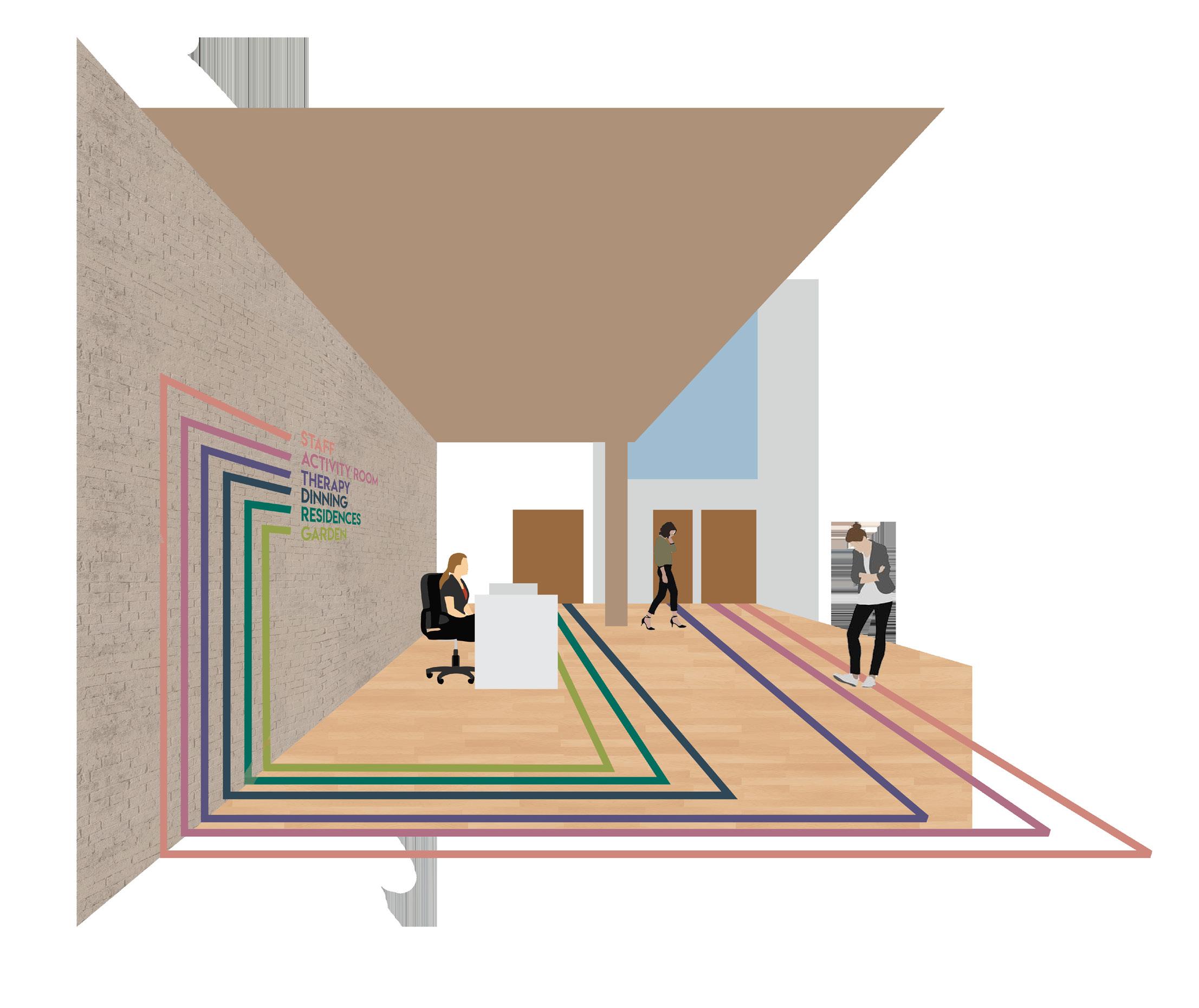
encourage the user to take control | strategies rediscover their identity | strategies
The possibility to change the space can empower and give the user a sense of contentment. Flexible spaces give control regarding the way users choose to use it, and it allows a space to be transformed to adjust to their needs. This can be encouraged by designing flexible partitions in residential units to accommodate families of different sizes, for example.
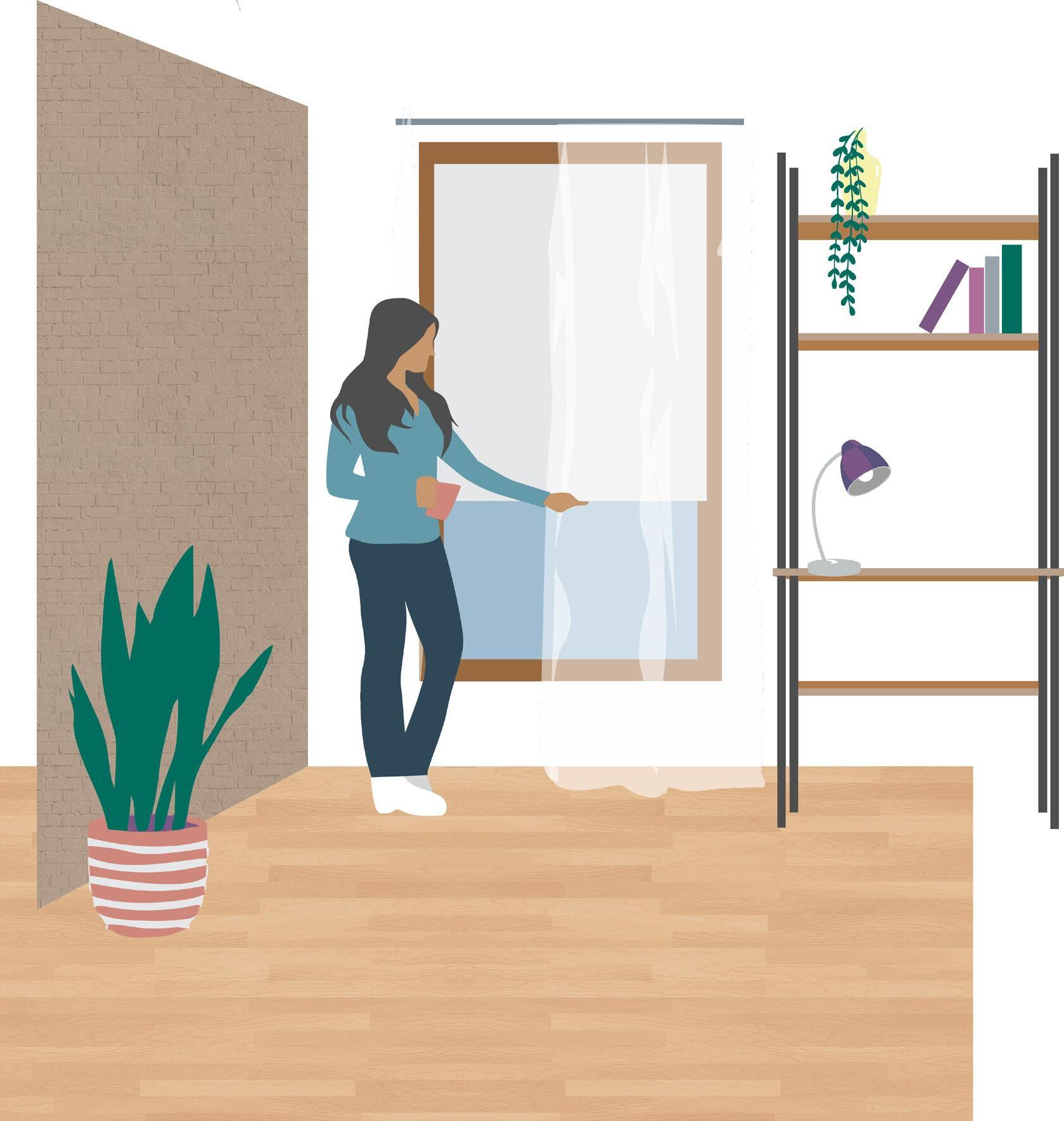
This can range from lighting and dimming controls, the ability to open windows, adjustable shading devices and room temperature, to access to secure storage facilities, or certain level of control over what and when to eat.
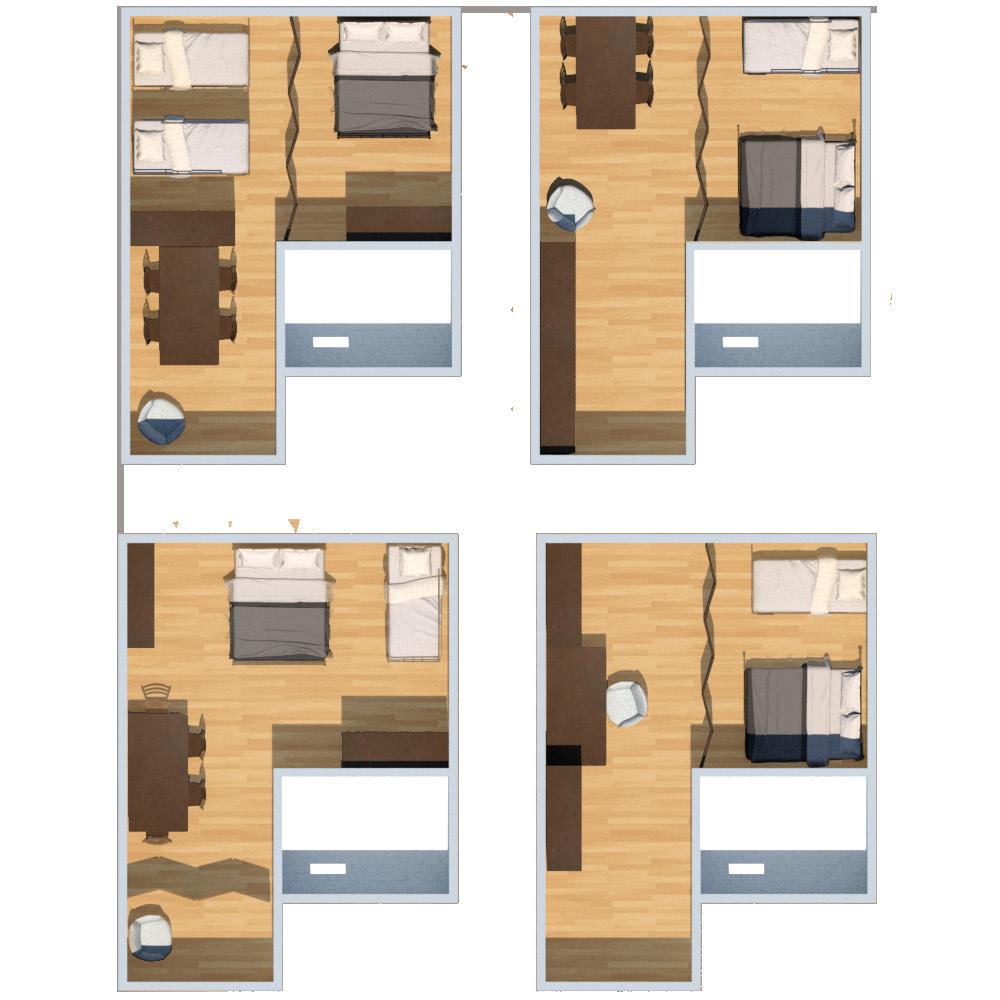
16. Enable the exploration of hobbies.
The ability to work towards achieving goals is important in building confidence. Whether that is going back to an activity they used to do, learn a new skill, or engaging in introspective activities (e.g. meditation), it is part of the process of reclaiming the self. This can be encouraged by including activity rooms or workshops.
17. Encourage physical activity.
When we are active, we produce endorphins which positively affect our moods and help reduce stress, and we get a sense of independence and we feel connected with ourselves, which may give a clearer sense of identity.
Spaces that encourage the user to exercise are not limited to gyms, but rather spaces ready for use at any time: walking tracks, recreational parks, or even large staircases in social areas that encourage the user to engage in physical activity.
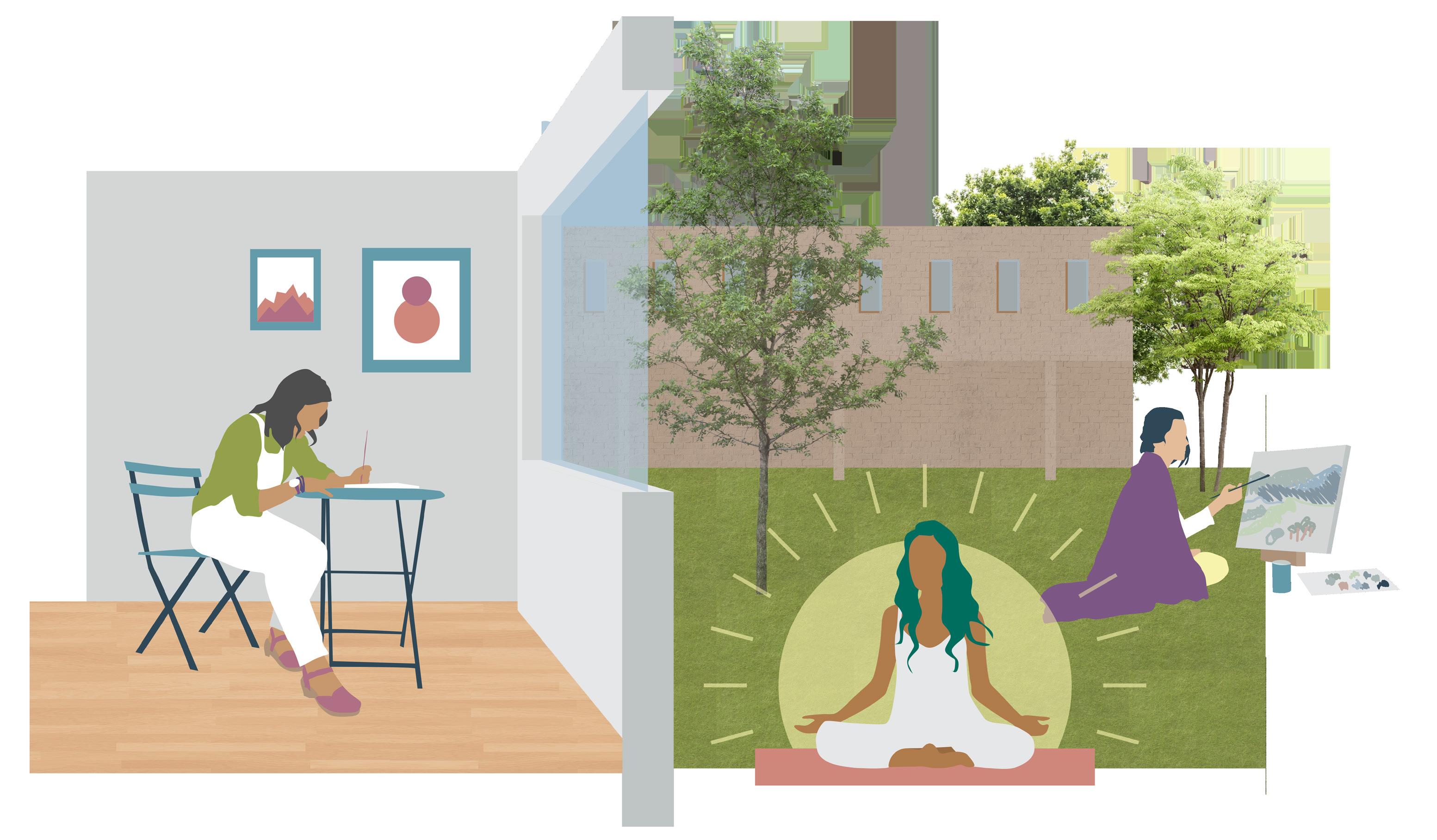
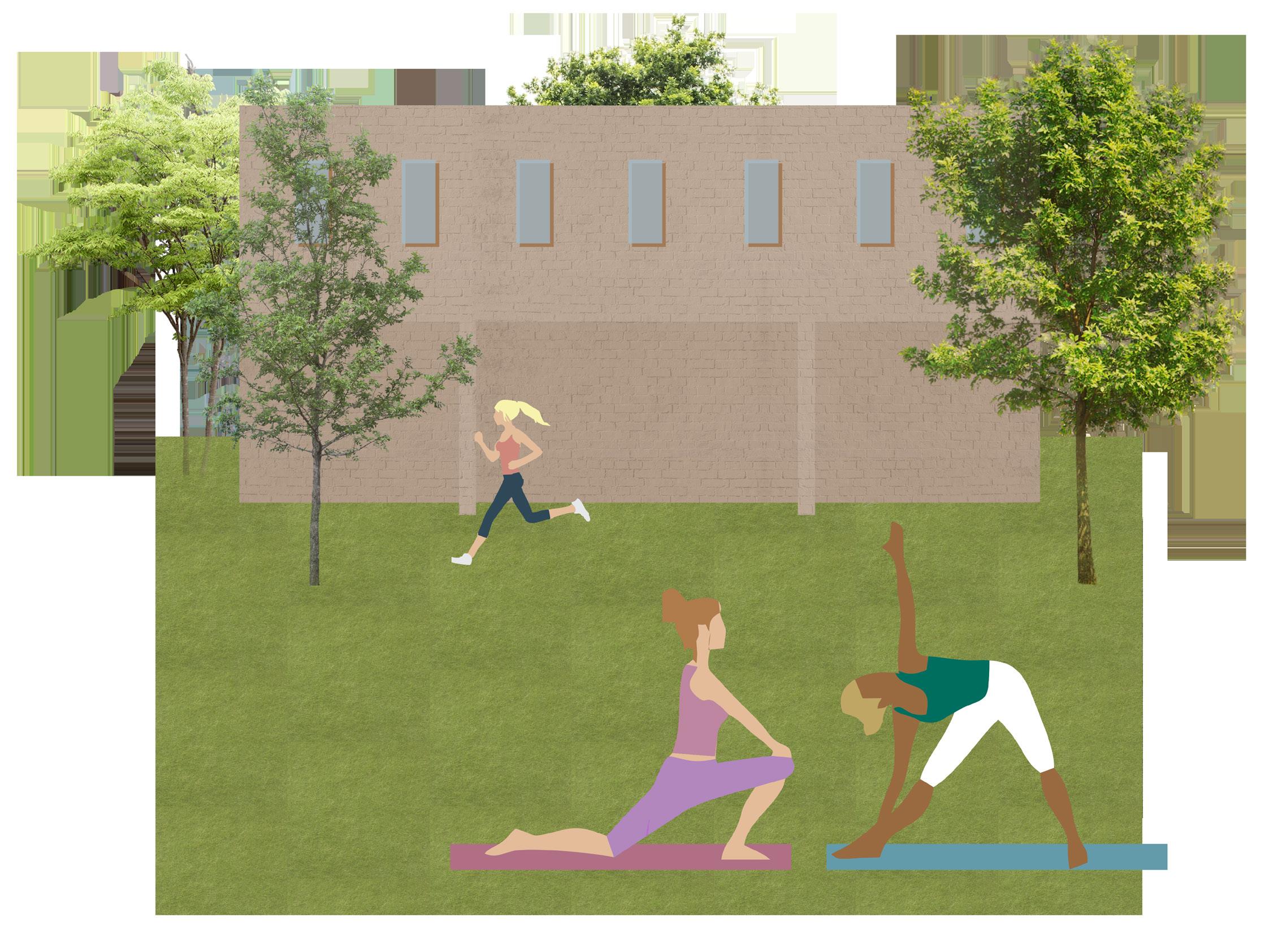
Stage 3 Reconnecting
Objective: connect with others
Two of the most common effects in DV victims is disempowerment and distancing from others. Creating new connections and relationships is fundamental in the recovery process.
connect with others | strategies
18. Encourage the presence of people.
Propose sitting areas and open plan spaces which prevent isolation. These spaces could have different functions: as activity rooms, exercise areas and workshops mentioned earlier.
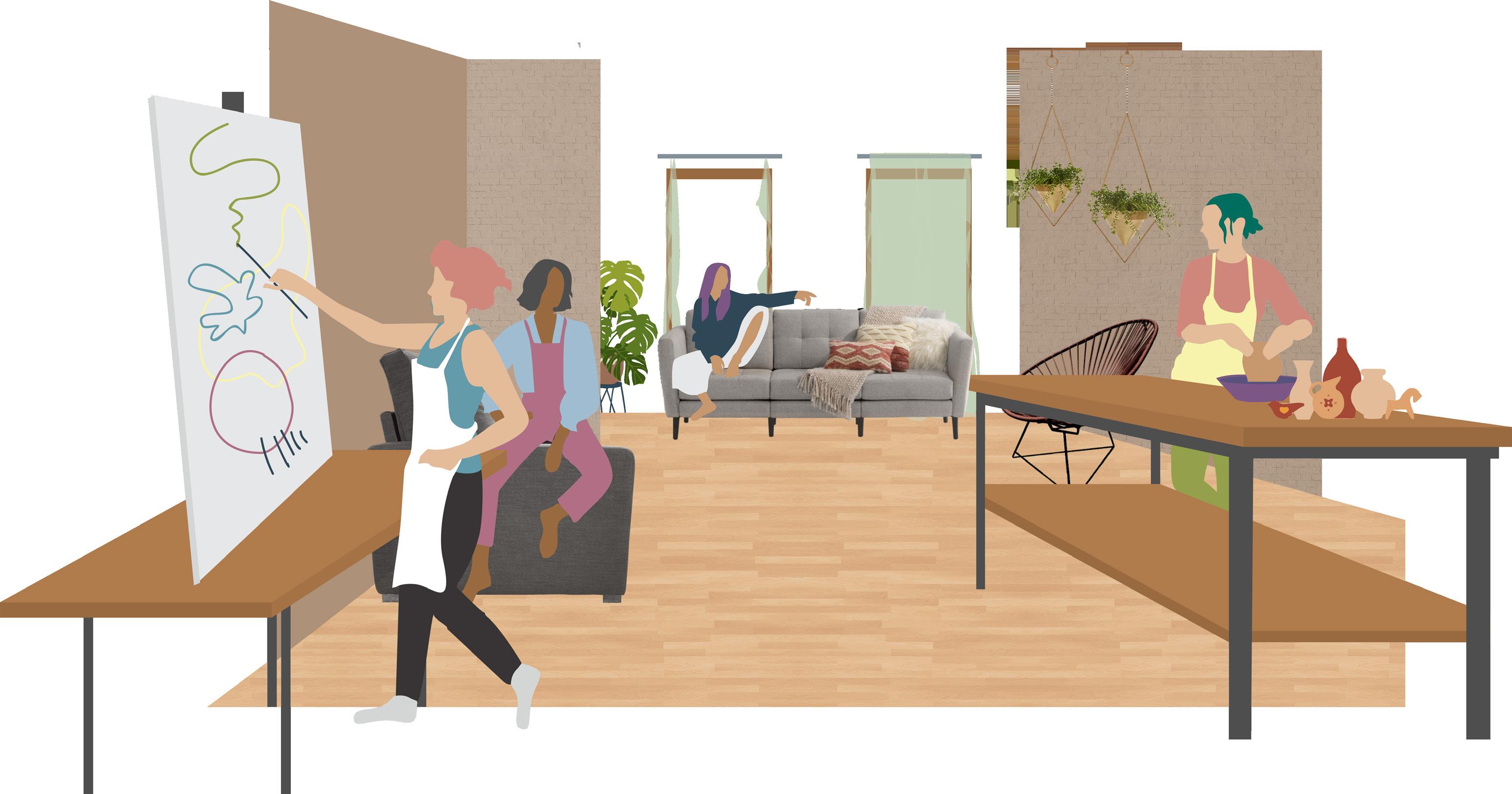
Having private personal areas is encouraged but having shared facilities of regular use may help create a community life which is important in the recovery process. Communal kitchens offer opportunities to bond and motivating users to be in their kitchen may result in healthier eating habits, giving them flexibility, control, and options to choose from.
This space could also benefit users who enjoy cooking or would like to learn by providing them with a comfortable space to engage in this activity.
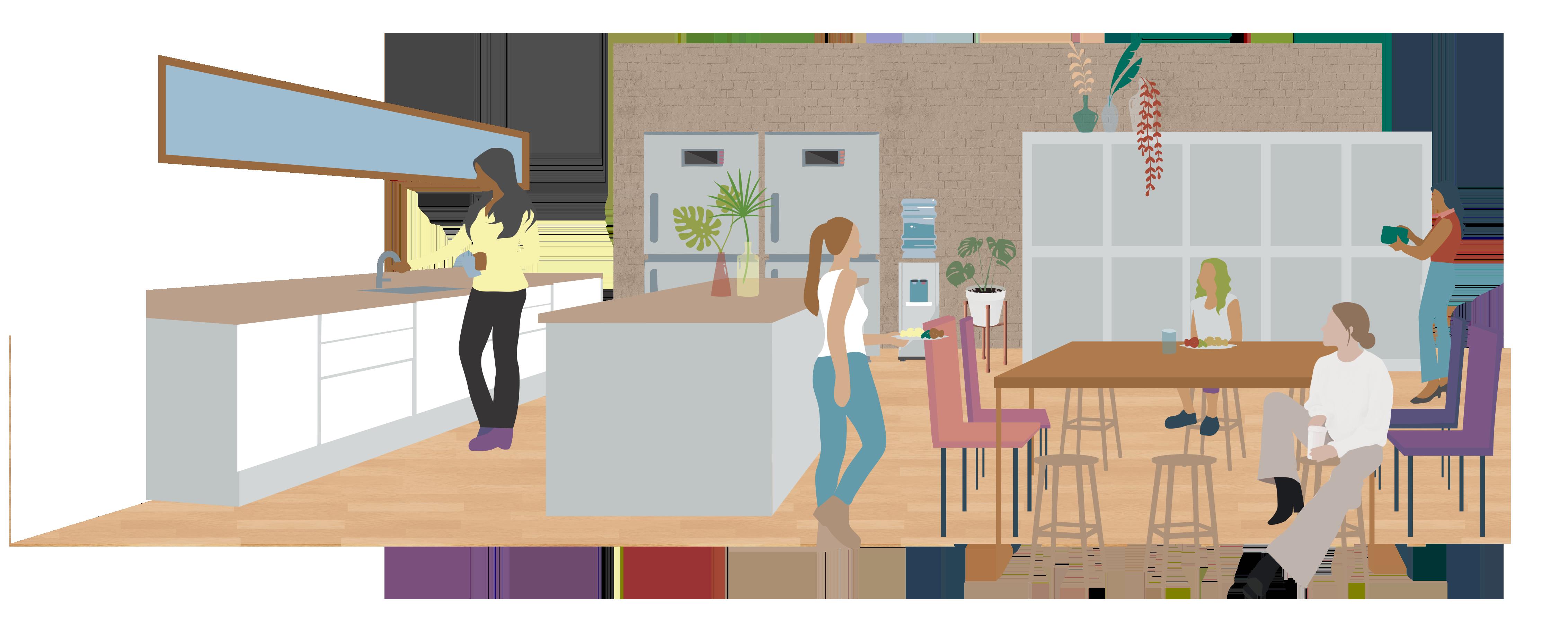
Kitchens should be pleasant and easy-to-use spaces, and the needs of families with small children must be considered, providing them with flexible access hours, or separate kitchenettes to prepare snacks or bottles as required.
Ecotherapy is an approach to improving mental health by participating in activities in nature. Benefits of proximity to nature have been discussed previously in this work, but additionally, engaging in activities such as gardening can make people feel more included and connected, improve self-esteem and combat depression. It also gives a sense of belonging, and taking care of plants, in the same way as caring for other living beings, produces an emotional reward in the user.
Consider integrating ponds, fountains, or pools into the project as proximity to water tends to make people happier.
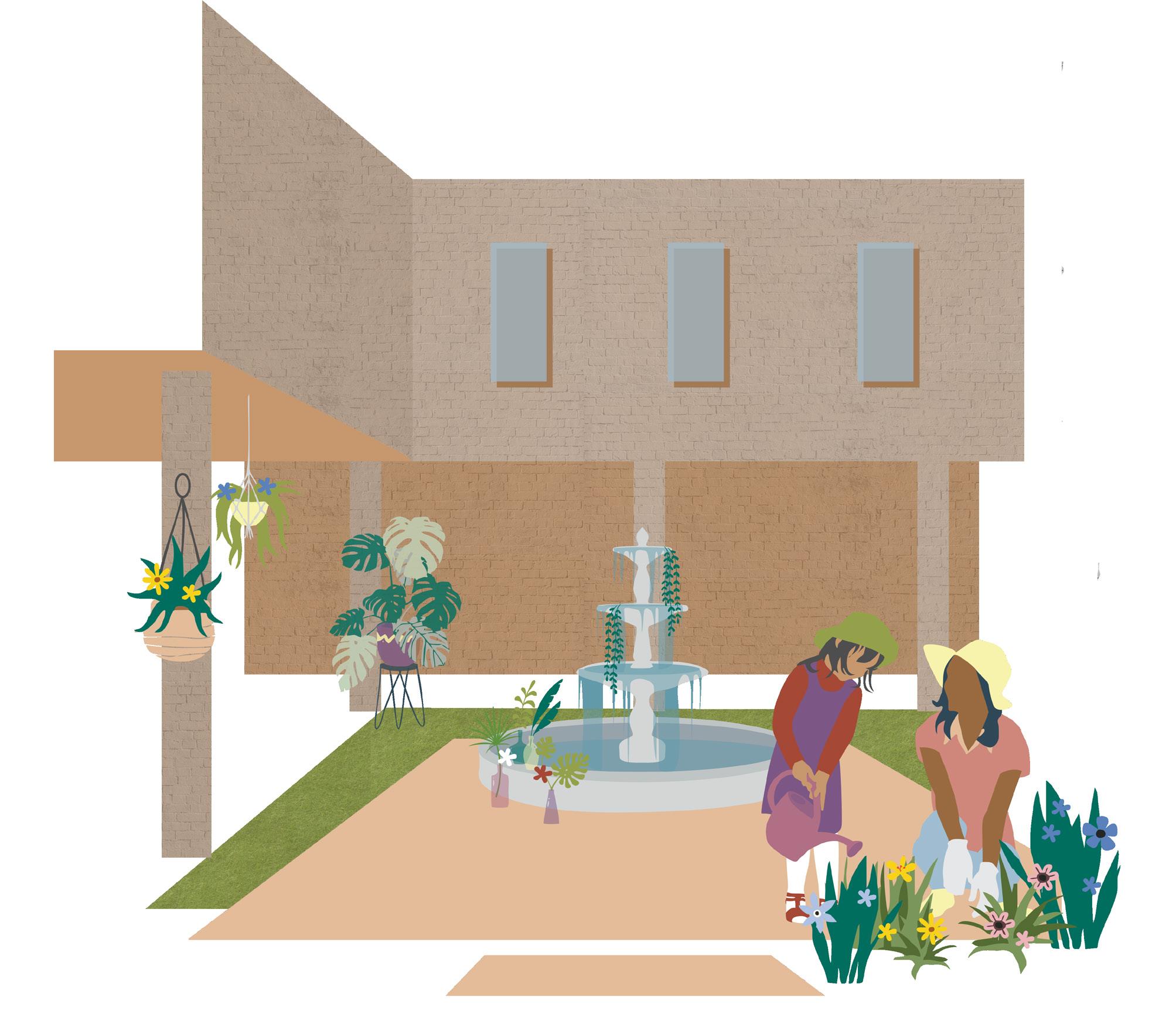
Key Moments Relevant Spaces Acknowledge
Arrival and initial adjustment to their temporary residence.
Establish the feeling of “home” and evidence the support available.
EMPOWER
Activities for recovery, including therapy sessions for women and children.
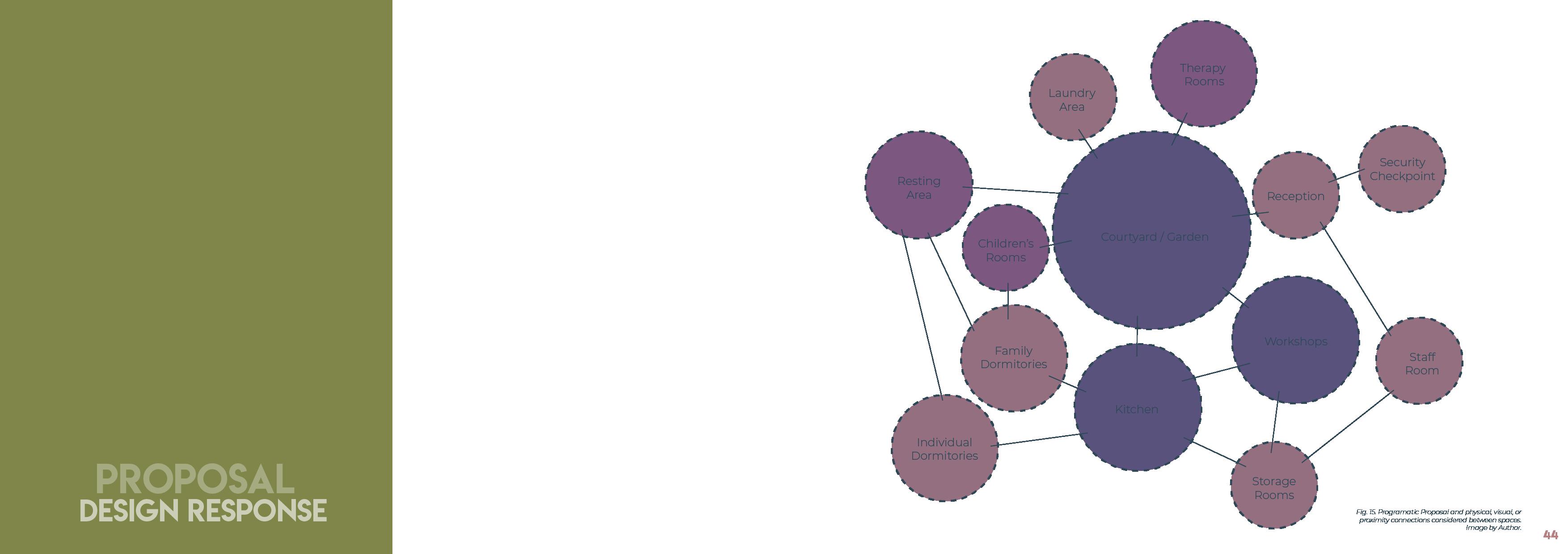
Security Checkpoint Reception
Staff Room Storage Rooms
Laundry Area
Individual dormitories
Family dormitories
Children’s Rooms
Resting Area Therapy Rooms
Reconnect
Given its “temporary” nature, spaces for developing skills for an independent life must be included, as well as social areas to enhance relationship building skills.
Workshop Area Kitchen Garden design elements and strategies ground floor
The trees covering part of the site will create an area for connecting with nature.
The working spaces are near the entrance to separate “public” and private areas, considering the workshops and therapy rooms could also be used by women who are not living in the shelter but still need the support it offers.
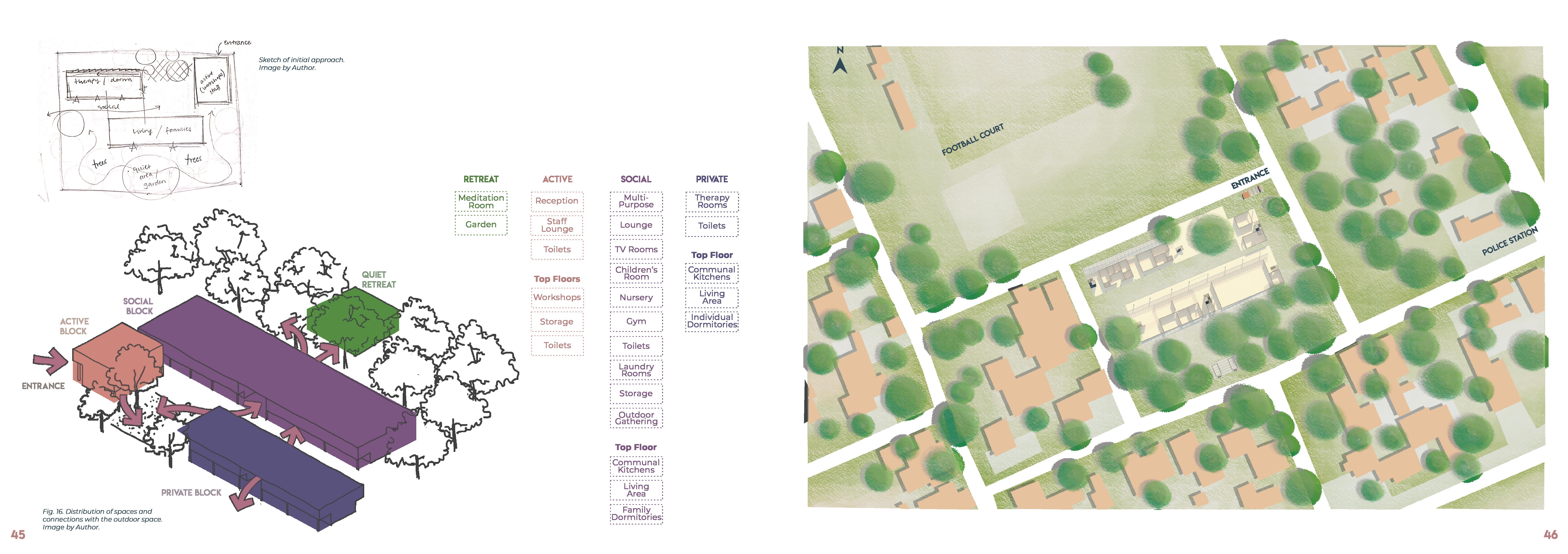

Sequence of barries for entering
Security checkpoint, followed by a reception. Flexible outdoors, covered, and indoors spaces.
Multi-functional spaces
Pocket of calm
Small space for quiet retreat, distanced from noisy social areas.
Interior courtyard
Meeting space articulating living, social, and active blocks.
Connections and corridors design elements and strategies
Minimized number of corridors except for exterior galleries (transition from indoors to outdoors and protection for the Northwest façade).
TOP floor
Elevated residential spaces
Bedrooms, private living rooms, and communal kitchens on top floors.
Relationship with nature
Living areas with natural views, either of the trees at the back, towards the inner courtyard, or towards vertical gardens which protect Northwest façades.
Separate individuals from families
Individual residents have calmer living areas while families are near social areas and children’s rooms.
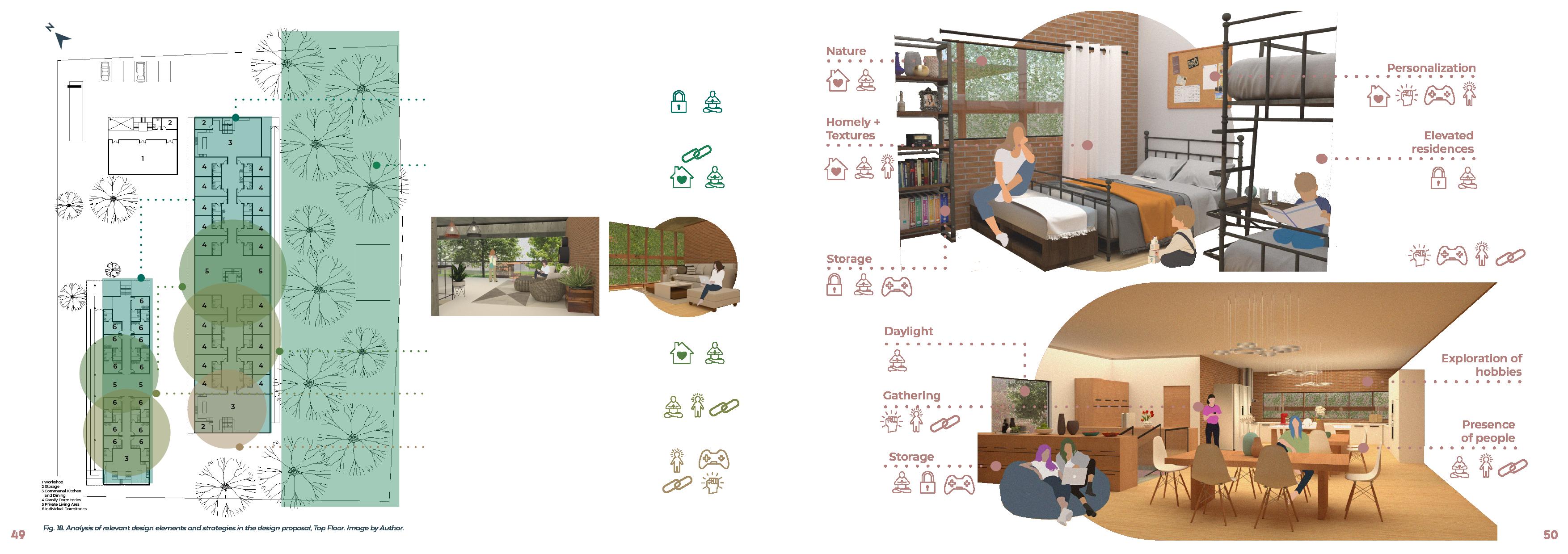
Encourage the presence of people
Residential floors broken at the middle with a shared living area.
Kitchen as a gathering place
Domestic Violence leaves in the victim physical and mental consequences. The recovery from this abuse varies from person to person, but it could be categorized in stages for a better understanding and support throughout the journey.

The support and tools victims receive with during the process are fundamental in the recovery, and so is the space in which these come together. This project provides insight on both the process and the factors that contribute to users’ wellbeing during this period, which can be implemented through design.
The strategies can be summarized as follows:
This paper exemplifies these strategies in a design proposal in the city of Ciudad del Este, Paraguay. By considering constructive and spatial elements that positively impact on mental wellbeing, the recovery process can be more pleasant and the assimilations during this period may be integrated deeper into the women’s perception of themselves and their reality.
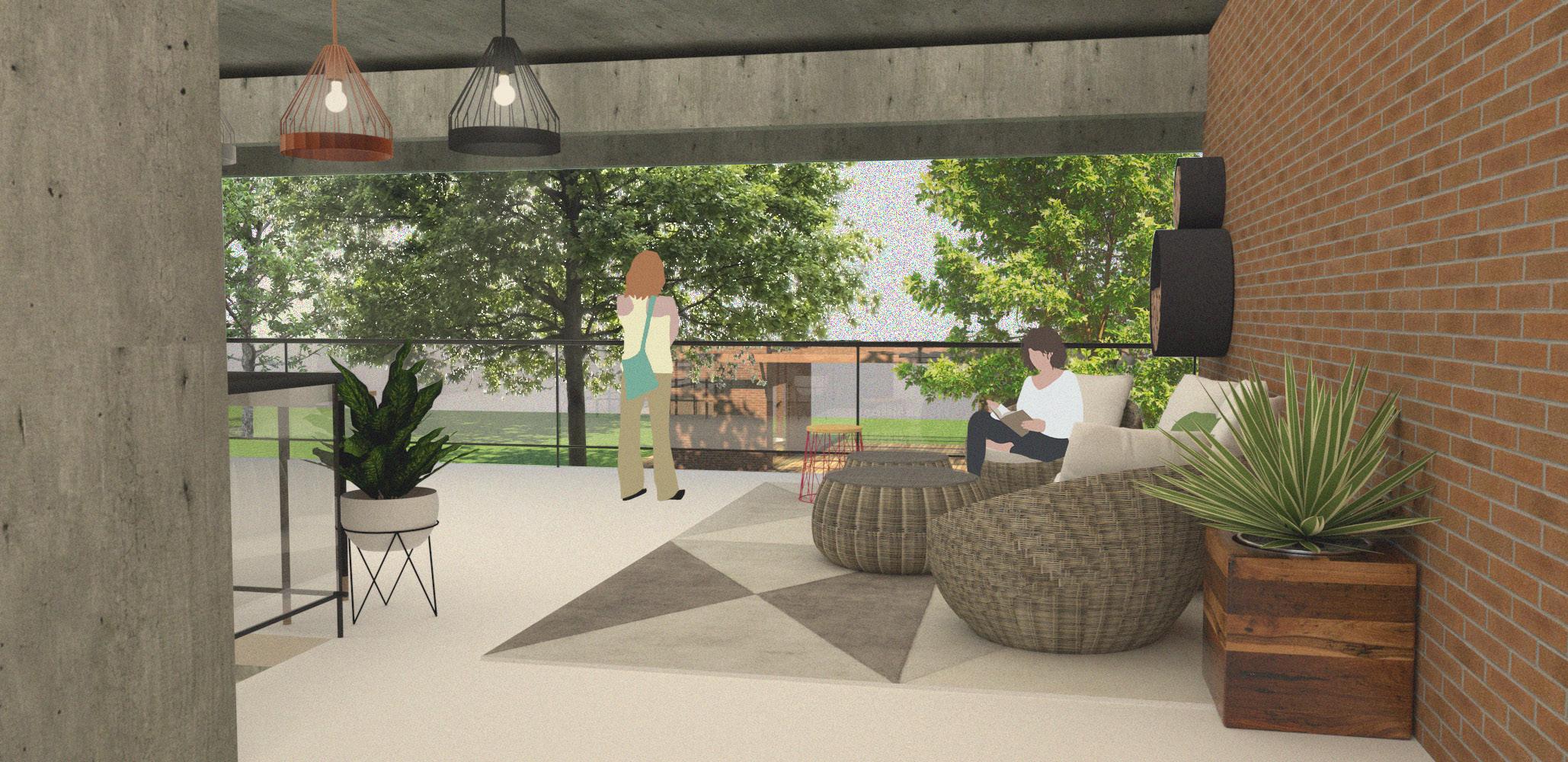

Adevi, A. A., & Lieberg, M. 2012. Stress rehabilitation through garden therapy. Urban Forestry & Urban Greening, 11(1), 51–58. https://doi.org/10.1016/j.ufug.2011.09.007
Al horr, Y., Arif, M., Katafygiotou, M., Mazroei, A., Kaushik, A., & Elsarrag, E. 2016. Impact of indoor environmental quality on occupant well-being and comfort: A review of the literature. International Journal of Sustainable Built Environment, 5(1), 1–11. https://doi.org/10.1016/j.ijsbe.2016.03.006
Allen, K. N. & Wozniak, D. F. 2010. The Language of Healing: Women's Voices in Healing and Recovering From Domestic Violence, Social Work in Mental Health, 9:1, 37-55, DOI: 10.1080/15332985.2010.494540
Braun, V. and Clarke, V. Thematic analysis | a reflexive approach. The University of Auckland.
Chanmugam, A. 2011. Perspectives on U.S. domestic violence emergency shelters: What do young adolescent residents and their mothers say? Child Care in Practice, 17, 393–415
Channon, B. 2019. Happy by design: A guide to architecture and mental wellbeing. RIBA Publishing.
Donnelly, S., Dean, S., Razavy, S., & Levett-Jones, T. 2019. Measuring the impact of an interdisciplinary learning project on nursing, architecture and landscape design students’ empathy. Plos One, 14(10), e0215795. https://doi.org/10.1371/journal.pone.0215795
Deutsche Welle. 2020. COVID-19: ¿qué ha hecho América Latina para evitar más feminicidios? DW Akademie. Retrieved from https://www.dw.com/es/covid-19-qu%C3%A9-ha-hecho-am%C3%A9rica-latina-para-evitar-m%C3%A1s-feminicidios/a-54356170#:~:text=1.932%20mujer es%20han%20sido%20asesinadas,ese%20mismo%20per%C3%ADodo%20en%20
2019
Economic Commission for Latin America and the Caribbean. 2019. Muerte de mujeres ocasionada por su pareja o ex-pareja íntima. Observatorio de Igualdad de Género. Retrieved from https://oig.cepal.org/es/indicadores/muerte-mujeres-ocasionada-su-pareja-o-ex-pareja-intima
Elías, M. 2021. Interview by Fernanda Castillo [virtual medium], 4 August.
Evans G. W. & Mitchell McCoy J. 1998. When buildings don’t work: The role of architecture in Human Health. Journal of Environmental Psychology 18, 85–94 0272-4944/98/010085+10$30·00/0.
Feder G. S., Hutson M., Ramsay J. & Taket A. 2006. Women Exposed to Intimate Partner Violence: Expectations and Experiences When They Encounter Health Care Professionals: A Meta-analysis of Qualitative Studies. Archives of Internal Medicine, 166(1), 22. https://doi.org/10.1001/archinte.166.1.22
Fernández-González, L., Calvete, E., Orue, I., & Mauri, A. 2018. Victims of Domestic Violence in Shelters: Impacts on Women and Children. The Spanish Journal of Psychology, 21, 18. https://doi.org/10.1017/sjp.2018.21
Flasch, P. Murray, C. E., & Crowe, A. 2015. Overcoming abuse: A phenomenological investigation of the journey to recovery from past intimate partner violence. Journal of Interpersonal Violence.
Freuer, J., 2021. The Clutter Culture - UCLA Magazine. [online] UCLA Magazine. Available at: <http://magazine.ucla.edu/features/the-clutter-culture/index1.html>
Gifford, R. 2015. Research methods for environmental psychology [electronic resource]. Hoboken: Wiley.
Graham, N., & Brickell, K. 2019. Sheltering from domestic violence: Women’s experiences of punitive safety and unfreedom in Cambodian safe shelters. Gender, Place & Culture, 26(1), 111–127. https://doi.org/10.1080/0966369x.2018.1557603
Grieder, M. A., & Chanmugam, A. 2013. Applying Environmental Psychology in the Design of Domestic Violence Shelters. Journal of Aggression, Maltreatment & Trauma, 22(4), 365–378. https://doi.org/10.1080/10926771.2013.775984
Inter-American Commission on Human Rights. 2013. Annual Report of the Inter-American Commission on Human Rights 2012. Washington, DC: Inter-American Commission on Human Rights.
Ley N° 5777. 2017. De Protección Integral A Las Mujeres, Contra Toda Forma De Violencia. Asunción, Paraguay: Decidamos, Campaña por la Expresión Ciudadana.
Loftness V., Hakkinen B., Adan O. & Nevalainen A. 2007. Elements That Contribute to Healthy Building Design. Environmental Health Perspectives. 115:965–970. available via https://doi.org/10.1289/ehp.8988
Kopec, D. 2006. Environmental psychology for design. New York: Fairchild.
Martin, P. Y. 2002. Sensations, bodies, and the “spirit of place”: Aesthetics in residential organizations for the elderly. Human Relations, 56, 861–885
Mathes, E. W. 1981. Maslow’s Hierarchy of Needs as a Guide for Living, Journal of Humanistic Psychology, 21(4), pp. 69–72. doi: 10.1177/002216788102100406.
Martínez, M. J. 2020. Quedarse en casa aumentó el riesgo de sufrir violencia. Pandemia Invisible. Retrieved from https://pandemiainvisible.lalupa.press/sobre-la-investigacion/
Menjívar, C., & Walsh, S. D. 2017. The Architecture of Feminicide: The State, Inequalities, and Everyday Gender Violence in Honduras. Latin American Research Review, 52(2), 221–240. https://doi.org/10.25222/larr.73
Mind for better mental health. 2017. Stress. Mind. Retrieved from https://www.mind.org.uk/media-a/2959/stress-2017.pdf
Ministerio de la Mujer. 2019. Feminicidios en Paraguay en los últimos años. Portal MinMujer. Retrieved from http://www.mujer.gov.py/index.php/noticias/feminicidios-en-paraguay-en-los-ultimos-anos
Ministerio de la Mujer. 2021. Resumen de víctimas de feminicidio en el Paraguay. Observatorio de la Mujer. Retrieved from: http://observatorio.mujer.gov.py/application/files/4316/1642/0864/ACTUALIZADO_AL_14_de_MARZO_DE_2021.pdf
National Institute of Statistics. 2021. Alto Paraná: Proyecciones de población por sexo y edad, 2021. Asunción, Paraguay: Instituto Nacional de Estadística.
Pan American Health Organization & Centers for Disease Control and Prevention. 2012. Violence Against Women in Latin America and the Caribbean: A comparative analysis of population-based data from 12 countries. PAHO. Retrieved from https://iris.paho.org/bitstream/handle/10665.2/3471/Violence%20Against%20Women.pdf?sequence=1&isAllowed=y
Refuerzo, B. J., & Verderber, S. 1993. In Support of A New Life: A Shelter For Victims of Domestic Violence. Journal of Architectural and Planning Research, Spring, 1993, (Spring, 1993), 10(1), 40–58. https://www.jstor.org/stable/43029275
Semenova, N. 2018. Power, Architecture, Transition: Creating A Safe Space For Victims Of Domestic Violence. University of Waterloo.
Smith, R., & Watkins, N. 2010. Therapeutic environments. Whole Building Design Guide. Retrieved from http://www.wbdg.org/resources/therapeutic. php?r=clinic_health
Solís Delgadillo, J. M. & Moriconi Bezerra, M. 2018. Atlas de la Violencia en América Latina — 1a. ed. San Luis Potosí, México: Universidad Autónoma de San Luis Potosí.
Universidad Autónoma de San Luis Potosí, Sternberg, E. 2009. Healing Spaces: The Science of Place and Well-Being. The Berlknap Press of Harvard University Press.
United Nations. What is domestic abuse? United Nations Publications. Retrieved from https://www.un.org/en/coronavirus/what-is-domestic-abuse.
United Nations Human Rights Office of the High Commissioner. 1993. Declaration on the Elimination of Violence against Women. Retrieved from https://www.ohchr.org/EN/Issues/Women/Pages/VaW.aspx
UN Women. 2020. Hechos y cifras: Poner fin a la violencia contra las mujeres. UN Women. Retrieved from https://www.unwomen.org/es/what-we-do/ending-violence-against-women/facts-and-figures
World Health Organization. 2012. Understanding and addressing violence against women. Geneva, Switzerland: WHO Press.
WHO. 2013. Global and regional estimates of violence against women: prevalence and health effects of intimate partner violence and non-partner sexual violence. Geneva, Switzerland: WHO Press.
Zayas Guggiari, L. 2021. Interview by Fernanda Castillo [virtual medium], 28 July.
List of Figures
Comparison of the number of femicides and orphaned children as a result during the years 2019 and 2020. Source: Ministerio de la Mujer. 2021. Resumen de víctimas de feminicidio en el Paraguay. Observatorio de la Mujer. 07
Comparison of Total Homicide Rate per 100.000 inhabitants in South American countries during the years 2019 and 2020. Source: Asmann, P. and Jones, K., 2021. Balance de InSight Crime de los homicidios en 2020. [online] InSight Crime. Retrieved from: https://es.insightcrime.org/noticias/analisis/balance-insight-crime-homicidi os-2020/#:~:text=Las%20autoridades%20de%20Paraguay%20registraron,ofi ciales%20del%20Ministerio%20del%20Interior. 08
Location of Paraguay within South America. Image by Author. 09
Map of the population density in Paraguay, where Ciudad del Este can be seen as the second most dense urban center in the country. Source: Socioeconomic Data and Applications Center (SEDAC). 2000. Population Density, Paraguay 2000. SedacMaps Retrieved from: https://www.flickr.com/photos/54545503@N04/6171916797/in/album-721576
42559645865/ 11
Percentage of the Paraguayan population who live in the Department of Alto Paraná. Source: National Institute of Statistics. 2021. Alto Paraná: Proyecciones de población por sexo y edad, 2021. Asunción, Paraguay: Instituto Nacional de Estadística. 11
Cities in the Triple Frontier. Image by Author. 12
Population of Alto Paraná and average income per gender. Source: National Institute of Statistics. 2021. Atlas de Género. Asunción, Paraguay: Instituto Nacional de Estadística. 12
Ciudad del Este city limits and zonification. Source: Google Earth Pro. 13
Location of the selected site within the San Lucas and Santa Ana neighborhoods. Source: Google Earth Pro, Google Maps. 14
Shelter for Victims of Domestic Violence, by Amos Goldreich Architecture + Jacobs Yaniv Architects. Source: Amos Goldreich Architecture. 15
Analysis of relevant design elements and strategies in the Shelter for Victims of Domestic Violence. Source: Amos Goldreich Architecture. 16
Refuge for Women Victims of Domestic Violence, by Origen 19ª 41’ 53” N Arquitectos. Source: Plataforma Arquitectura 17
Analysis of relevant design elements and strategies in the Refuge for Women Victims of Domestic Violence, by Origen 19ª 41’ 53” N Arquitectos. Source: Plataforma Arquitectura. 18
Comparison between different Models of Recovery from Domestic Violence.
Sources: Isobel Heywood, Dana Sammut & Caroline Bradbury-Jones (2019) A qualitative exploration of ‘thrivership’ among women who have experienced domestic violence and abuse: Development of a new model, BMC Women’s Health; Paulina Flasch, Christine E. Murray, and Allison Crowe (2015) Overcoming abuse: A phenomenological investigation of the journey to recovery from past intimate partner violence. Journal of Interpersonal Violence; Karen Neuman Allen L & Danielle F. Wozniak (2010) The Language of Healing: Women's Voices in Healing and Recovering From Domestic Violence, Social Work in Mental Health. 20
Programatic Proposal and physical, visual, or proximity connections considered between spaces. Image by Author 44
Distribution of spaces and connections with the outdoor space. Image by Author. 45
Analysis of relevant design elements and strategies in the design proposal, Ground Floor. Image by Author. 47
Analysis of relevant design elements and strategies in the design proposal, Top Floor. Image by Author. 49





